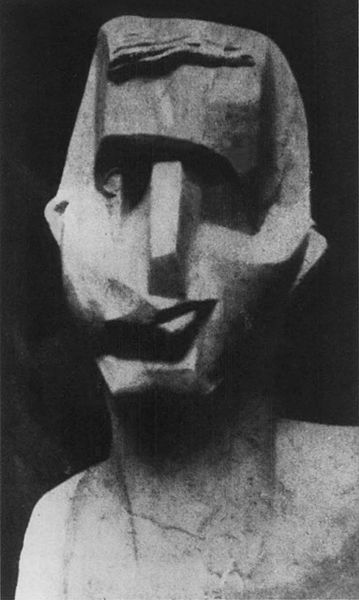Joseph Csaky was a Hungarian avant-garde artist, sculptor, and graphic artist, best known for his early participation in the Cubist movement as a sculptor. Csaky was one of the first sculptors in Paris to apply the principles of pictorial Cubism to his art. A pioneer of modern sculpture, Csaky is among the most important sculptors of the early 20th century. He was an active member of the Section d'Or group between 1911 and 1914, and closely associated with Crystal Cubism, Purism, De Stijl, Abstract art, and Art Deco throughout the 1920s and 1930s.
Joseph Csaky in 1926
Joseph Csaky, 1911–12, Groupe de femmes, plaster lost, photo Galerie René Reichard, Frankfurt. Exhibited at the 1912 Salon d'Automne, and Salon des Indépendants, 1913, Paris
Joseph Csaky, 1912, Danseuse (Femme à l'éventail, Femme à la cruche), original plaster, exhibited at the Salon d'Automne of 1912, Paris, n. 405, and Salon des Indépendants of 1914, n. 813, photo from Csaky archives AC.110
Joseph Csaky, Head (Tête d'homme), 1913, Plaster lost. Photo published in Montjoie! March 1914, also Richard, René, 1988
Cubism is an early-20th-century avant-garde art movement begun in Paris that revolutionized painting and sculpture, and inspired artistic movements in music, literature, and architecture. In Cubist works of art, the subjects are analyzed, broken up, and reassembled in an abstract form—instead of depicting objects from a single perspective, the artist depicts the subject from multiple perspectives to represent the subject in a greater context. Cubism has been considered the most influential art movement of the 20th century. The term cubism is broadly associated with a variety of artworks produced in Paris or near Paris (Puteaux) during the 1910s and throughout the 1920s.
Pablo Picasso, 1910, Girl with a Mandolin (Fanny Tellier), oil on canvas, 100.3 × 73.6 cm, Museum of Modern Art, New York
Pablo Picasso, Les Demoiselles d'Avignon, 1907, considered to be a major step towards the founding of the Cubist movement
Albert Gleizes, L'Homme au Balcon, Man on a Balcony (Portrait of Dr. Théo Morinaud), 1912, oil on canvas, 195.6 × 114.9 cm (77 × 45 1/4 in.), Philadelphia Museum of Art. Completed the same year that Albert Gleizes co-authored the book Du "Cubisme" with Jean Metzinger. Exhibited at Salon d'Automne, Paris, 1912, Armory show, New York, Chicago, Boston, 1913.
The "Cubists" Dominate Paris' Fall Salon, The New York Times, October 8, 1911. Picasso's 1908 Seated Woman (Meditation) is reproduced along with a photograph of the artist in his studio (upper left). Metzinger's Baigneuses (1908–09) is reproduced top right. Also reproduced are works by Derain, Matisse, Friesz, Herbin, and a photo of Braque.








